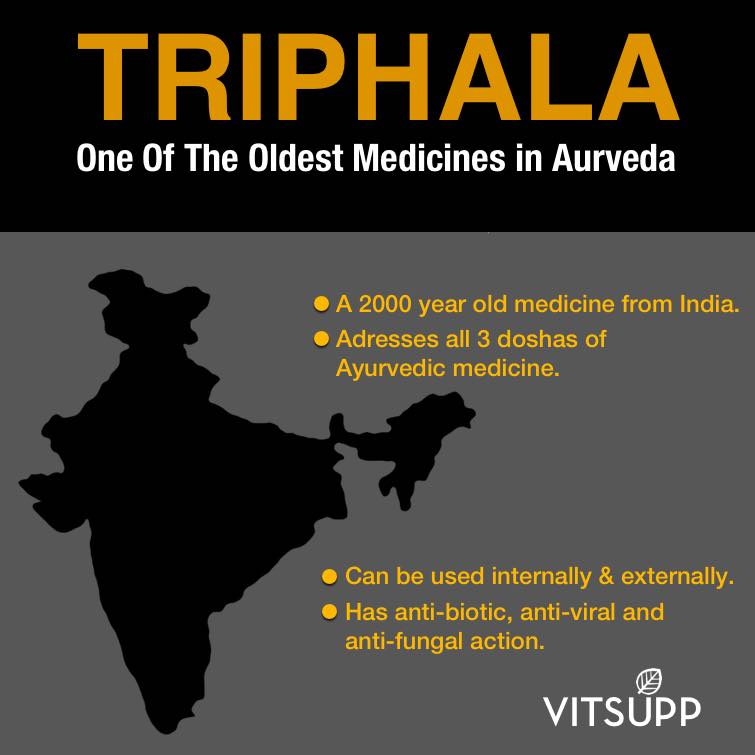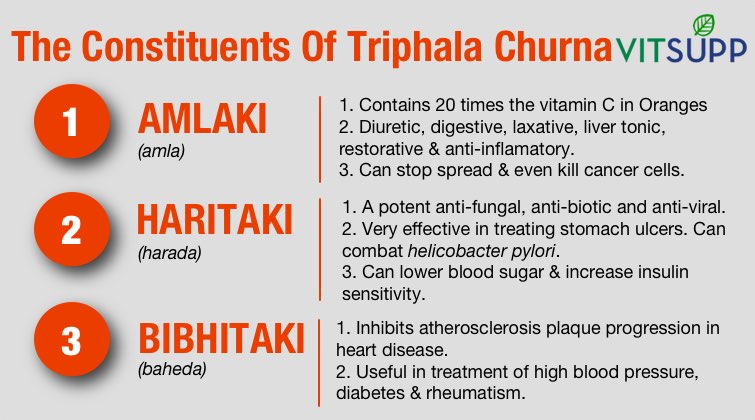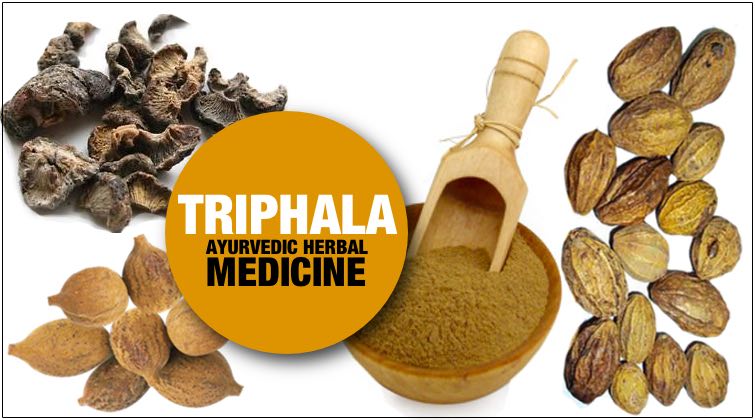Contents
What is triphala powder?
Triphala means “teen phal” or three fruits. (Tri = Teen = Three & Phala = Phal = Fruits)
Triphala churna is a 2000-year-old traditional Ayurvedic herbal formulation.
This ayurvedic medicine consists of three fruits native to the Indian subcontinent:
- Amalaki (Emblica Officinalis)
- Bibhitaki (Terminalia bellirica)
- Haritaki (Terminalia chebula).

Triphala is one of the oldest and most versatile ayurvedic medicine used in India. It is an Ayurvedic herbal formulation that has universal curative powers and is beneficial for a broad range of ailments.
You can find references to Triphala Churn uses in ancient India in Sushrut Samhita, which is dated as far back as 1500 BC.
Most people know and use it as a bowel tonic & mild laxative. However, the other benefits of this herb are even more noteworthy.
To understand why Triphala is so unique, we need to know its ingredients and their effects on the doshic balance of the body.
Triphala churna ingredients
To make this Ayurvedic medicine, all the three ingredients of Triphala are powdered and sold in various proportions in powder (Churna), Capsule or tablet form. A Large number of Indians consume Triphala juice as well for maximum therapeutic benefits.
However, before we talk about Triphala Benefits let me share some more info on the three Triphala Ingredients:

1. Amalaki or Amla (Emblica Officinalis):
Amla, (pronounced aamlaa) is known botanically as Emblica Officinalis. It is low in calories and is made up of over 80% water.
Amla or the Indian gooseberry is considered to be a superfood. It has proven to be an effective herbal medicine for the treatment and prevention of eye disease, cancer, digestive problems, diabetes and other health issues.
Amla has even been shown to slow ageing. Amla is also the richest natural source of vitamin C in the form of ascorbic acid, containing 600mg per 100 grams in an easily absorbable form.
It also contains protein, fibre, phosphorous, iron, carotene and vitamin B complex, and gallic acid according to the Indian Council of Medical Research.
2. Haritaki or Harada (Terminalia chebula):
Harada has been used widely for many centuries in both Ayurvedic and Tibetian medicine.
In Tibetan medicine, it is famous as the “king of medicine.”
Many depictions of the healing form of Gautam Buddha show him extending a handful of Haritaki. It’s believed to have:
- A variety of positive health effects on the heart and brain
- It decreases Stomach Acidity and Guards against Ulcers
- Antioxidant polyphenols like gallic acid and ellagic acid that have been shown in studies to combat the Helicobacter pylori bacteria and reduce your risk of developing stomach ulcers.
It is a potent anti-fungal, anti-bacterial as well as antiviral. It lowers blood sugar levels and increases insulin sensitivity. Haritaki fruit powder is a tried and tested remedy for skin problems (like acne and skin rashes) and for hair loss and dandruff.
3. Bibhitaki or Baheda (Terminalia bellirica):
Baheda or Bibhitaki is a powerful ancient detoxifier with detoxifying qualities on the blood, muscles, and fatty tissue of the body. Bibhitaki is very useful with conditions involving excess mucous in the system and is also good for quality bone formation. It has multiple benefits on Kapha dosh of the body.
Interesting facts about triphala
- It is one of the oldest herbal remedies in Ayurveda. References to the use of Triphala is in the Sushrut Samhita, which is an ancient Sanskrit textbook on medicine and surgery dated to 1500 BC.
- It contains five of the six tastes recognised in Ayurveda (sweet, sour, bitter, pungent and astringent). It’s only missing the salty taste.
- All the three fruits of Triphala each correspond to one of the three doshas of Indian Ayurvedic medicine.
- Amla, one of Triphala’s three fruits, is said to have 20 times the vitamin C content of an orange which makes it a superfood.
- A paste of turmeric and Triphala with coconut oil can also be applied topically to the skin to speed the healing of wounds and sunburns.
- Triphala has anti-fungal, antibiotic and anti-viral action.
10 Benefits of triphala churna (powder / capsule / tablet)
1. For Cancer Management
Triphala exerts an anti-proliferative (stops the growth of cancer cells) and pro-apoptotic (encouraging the programmed cell death of cancer cells) effect on colon cancer cells and human colon cancer stem cells.
Researchers have found that the methanol extract of Triphala contains a variety of phenolics including naringin, quercetin, homoorientin, and isorhamnetin.
The researchers have found that Triphala was able to suppress the multiplication of cancer cells. They also found that besides stopping the cancer growth, the its extract was also able to induce cell death of human colon cancer stem cells. We believe this makes Triphala a worthy candidate for further anti-cancer research.
Gallic acid is another constituent of Triphala. This compound has also shown promising anticancer activity in scientific research. Especially in prostate cancer cells.
In a country like India where tobacco-induced mouth cancer is so common Triphala is essential. In fact research has shown that a Triphala based mouth rinse can help reverse tobacco-induced oral precancerous lesions (2014)!
Further studies have also proved that it can kill tumor cells but spare healthy cells. Therefore Triphala is a highly promising option as a potential anticancer drug without side effects, unlike chemotherapy.
2. As A Natural Laxative & Colon Cleanser
Triphala, when taken correctly at the appropriate time, can act as a source of nourishment and mild laxative. It is widely known to nourish the digestive tract and regulate bowel movements.
It is a natural colon cleanser. Having regular bowel movements are essential for removing bacteria, eliminating waste like heavy metals and eliminating excess fatty acids from the body.
A stool impacted colon can cause a myriad of problems ranging from fatigue, anxiety to re-absorption of toxins to outright pain. Here is how each of the constituents of Triphala help regulates digestion and elimination:
- Amla supports intestinal repair,
- Haritaki strengthens the abdominal muscles to contract more efficiently when the bowels need to move, and
- Bibhitaki pulls the old mucus off the wall.
How to take Triphala Churna for laxative action:
Take powdered Triphala with hot water (drinkable) at night one hour after dinner and at least a half hour before bed. According to Ayurveda, when taken at night it acts as a laxative, and when taken in the morning it acts primarily as nourishment.
Finally, if you suffer from chronic constipation add isabgol to Triphala. A 2011 study showed that a mixture of isabgol husk, senna extract and Triphala in powdered form was an effective, safe and non-habit-forming herbal laxative formulation for the management of constipation.
3. Triphala churna For Weight Loss
I am sure you have already read that Triphala can help reduce weight and fight of obesity. By correcting digestion and the elimination pathways of the body, it makes way for adjusting the body’s weight management abilities.

Research has now proven that the gut microbiome is primarily responsible for obesity.
In layman terms, the large colonies of fungus/opportunistic bacteria/viruses/parasites living inside us are responsible for our weight problems. They even induce us to make the wrong food choices.
Like us, these organisms residing inside us need nutrients to survive and grow. And when they grow to a substantial number they impact our food choices and food quantity intake. After all, in such cases, the human host is feeding colonies of parasitic organisms besides himself!
Triphala has anti-viral, anti-fungal and antibacterial action. This means that when it is taken consistently over a period, it will eliminate these parasitic organisms from your body.
Which means you will need less food and energy. Limiting sugars & processed foods of all kinds will hasten the process of recovery and weight loss.
For greater long-lasting benefits, add fermented foods to your diet to crowd out the bad organisms. Fermented foods such as homemade kefir, sauerkraut, yoghurt, khimchi are excellent.
Suggested Reading : Will Quitting Rice Help in losing Belly Fat?
Suggested Reading : How Probiotics help you lose weight and belly fat?
Study on Triphala Benefits for Weight Loss
One 2012 study investigated the effects of Triphala and its constituent fruits on diet-induced obesity and other symptoms of visceral obesity syndrome in mice.
The mice were fed a high-fat diet for ten weeks. Some of these mice had their diets supplemented with herbal preparations of Triphala and its constituents.
The mice that took Triphala or its component fruit extracts had significant reductions in body weight and percentage of body fat. The treatment also reversed pathological changes in liver tissue.
Studies of human obese subjects have had similar results. One recent study looked at obese men and women between 16 and 60 years of age. For 12 weeks, subjects were randomly assigned to take either five grams of Triphala or a placebo two times daily. The Triphala group experienced a significantly greater decrease in weight as well as waist and hip circumference as compared to the placebo group.
Triphala has antioxidant, free radical scavenging and laxative abilities, which all have a positive effect on metabolic health and control obesity.
4. For its anti-Inflammatory & anti-arthritic benefits
Almost all diseases involve some degree of inflammation. Arthritis is inflammation of one or more joints, which causes pain and stiffness that can worsen with age.
To combat arthritis, a smart natural approach should involve consuming anti-inflammatory foods and supplements. Studies on animals have shown that Triphala might be a helpful natural remedy for people living with arthritis. One study specifically showed that it improved bone and cartilage breakdown during rheumatoid arthritis.
5. Can help in Kidney dysfunction & reduce BP:
Scientists from the Institute of Natural Medicine at the University of Toyama, Japan sought to investigate the effects of amla on kidney disease in rats. Specifically, the scientists targeted oxidative stress in the kidneys of older mice. The rats were given either amla powder or an alcohol-based amla extract (tincture) for 100 days.
At the end of the study, it was visible that Amla had a positive effect on both the creatinine and urea nitrogen levels in the ageing rats. Also, blood pressure of the rats was lower with amla.
Suggested Reading : 3 Symptoms of High Blood Pressure to watch out for.
Suggested Reading: 10 Tips for Reducing Your High Blood Pressure.
6. Lowers blood sugar levels and increases insulin sensitivity
Triphala has also been shown in several previous studies to be beneficial in managing diabetes and metabolic problems, but its cellular targets are mostly obscure.
Research led by Nita Singh at Jiwaji University in Gwalior has identified, for the first time, a series of molecular and signalling pathway proteins that Triphala targets to stabilize glucose and lipid levels.
Also, a 12-month study on subjects with Type II Diabetes Mellitus concluded that an [Amalaki: Bibhitaki : Haritaki; 1:4:1] Triphala formulation could relieve multiple problems including high blood sugar and high lipid levels, and offer protection against the development of complications associated with the condition.
Union Health Ministry, Department of AYUSH is organizing the WAC, in collaboration with World Ayurveda Foundation and the Delhi Government.
7. Used to treat mouth ulcers and gum disease.
Haritaki is valuable in the prevention and treatment of several diseases of the mouth such as dental caries, spongy and bleeding gums, gingivitis, and stomatitis.
Haritaki extract could successfully prevent plaque formation on the surface of the tooth, as it inhibited the sucrose-induced adherence and the glucan-induced aggregation, the two processes which foster the colonization of Streptococcus mutans on the surface of the tooth.
Antimicrobial and antioxidant effect of Triphala has been proven in vitro as it has been shown to inhibit S. mutans at concentrations as low as 50 μg/ml. This antiplaque effect probably may be due to the tannic acid in Triphala, which is adsorbed well to the groups on the surface of the bacterial cells, which result in protein denaturation and ultimately to bacterial cell death.
Triphala presented an antiplaque efficacy similar to that of chlorhexidine (CHX) and was more efficient in inhibiting plaque formation with lesser or no side effects.
CHX is a dicationic bisbiguanide which is effective against an array of microorganisms including Gram-positive and Gram-negative bacteria, fungi, yeast, and viruses. It is regarded as the “gold standard” antiplaque treatment and is particularly effective against gingivitis.
However, most practitioners do not recommend the long-term and daily use of CHX as a mouthwash. This is mainly because of its side effects such as objectionable taste, tooth discolouration, desquamation, and soreness of oral mucosa.
Triphala extract mouthwash may be an alternative in such a scenario with no reported adverse effects.
8. Helps in Anemia
The high content of vitamin C in Triphala will assist in the absorption of iron. Ensure that you eat iron-rich foods for maximum iron absorption. Adding Lysine to the diet further hastens the absorption of iron from food.
Suggested Reading : Tea & coffee can make you sick if you are anemic!
9. Triphala helps in heart disease by lowering cholesterol levels
The much-maligned cholesterol is naturally occurring in foods. It is also something that our body can manufacture in the liver as required. It is essential for repair and function of cells & nerves. Also, cholesterol is the building block for hormones. Also, low cholesterol (less than 100) has been linked to cancer! So yes cholesterol is essential for the body.
However, when it is too high, it can be problematic. Cholesterol can combine with fat, calcium and other substances in the blood to form plaque. Plaque then slowly builds up and hardens in the arteries, causing them to narrow. This buildup of plaque is called atherosclerosis, which can lead to heart attack or stroke.
In 1988, the International Journal of Cardiology published a study involving 100 rabbits.
Scientists wanted to know the effects of three different Indian botanicals on the rabbits’ blood cholesterol levels. One of the botanicals was amla. The animals took a high cholesterol diet along with the botanicals.
After 16 weeks Cholesterol levels were measured against a control group of rabbits. The rabbits in the control group took only the high cholesterol diet. All three botanicals, including amla, significantly lowered blood, heart, and liver cholesterol levels compared to the control group.
Triphala has been found to reduce cholesterol and arterial plaque. A study published in the Journal of Nutritional Science and Vitaminology (Tokyo) in 2005 has confirmed the same. It has shown that total cholesterol, as well as LDL (“bad cholesterol”), can be significantly reduced in animal subjects with high cholesterol if treated with Triphala.
Bibhitaki has also been shown by researchers to inhibit atherosclerosis plaque progression.
10. Can Improve Colitis by helping rebuild Gut flora
Gut microbiota elicits the bio-activity of Triphala. The phytochemicals in Triphala promote the growth of beneficial gut microbes such as Bifidobacteria and Lactobacillus species in the digestive tract. It also inhibits the growth of less desirable and potentially more inflammatory gut residents such as Escherichia coli.
The enzymatic activity of lactic acid bacteria degrades tannins in Triphala such as gallic acid. The human gut microbiota also transforms Triphala-derived polyphenols such as chebulinic acid into metabolites such as urolithins, which have the potential to prevent oxidative damage and inflammation.
Results of another study showed that Triphala (300 mg/kg) has a considerable and reliable effect in reducing colitis in rats. They attributed the positive effect on colitis to its abundant presence of flavonoids and high antioxidant activity.
In other words it can help attain improved digestion as well as regulate bowel movements.
Triphala side effects & caution
1. You may suffer from Diarrhea
Triphala may cause Diarrhea when you first start taking it. This may be due to its cleansing and detoxification effects on your digestive tract. If you suffer loose stools or diarrhoea after starting Triphala, it means that your dose is too high. Just half your dose and build it up in a month.
2. Watch out for Dehydration
If you are using Triphala for laxative purposes, then you should make sure that you do not exhibit any signs of dehydration including muscle weakness, dizziness or excessive thirst. Discontinue its use if you have symptoms of dehydration.
3. Triphala can interact with prescription drugs
Some of the drugs include acetaminophen, paracetamol, caffeine, ibuprofen [blood thinning medication]; warfarin and fluvoxamine [antidepressant drug], and diazepam [most popular sedative drug].
4. Do not take it if you are on blood thinning medications.
5. Triphala is not suitable for pregnant or nursing women or children.
6. And of course, don’t think about it if you have diarrhea or dysentery.
If you have any ongoing health concerns or are taking other medications or supplements, check with your ayurvedic doctor or any other qualified health professional to make sure that Triphala is an acceptable herbal remedy for you.
References:
- Amla (Emblica Officinalis Gaertn), a wonder berry in the treatment and prevention of cancer, Pubmed
- Therapeutic Uses of Triphala in Ayurvedic Medicine, Pubmed
- Triphala in the prevention of dental caries and as an antimicrobial in oral cavity- a review, Pubmed
- Triphala, the Ayurvedic formulation for treating and preventing cancer: a review, Pubmed
- Effect of Extracts of Terminalia chebula on Proliferation of Keratinocytes and Fibroblasts Cells: An Alternative Approach for Wound Healing, Pubmed
- The Ayurvedic medicines Haritaki, Amala and Bahira reduce cholesterol-induced atherosclerosis in rabbits, Pubmed
- Terminalia bellirica Extract Inhibits Low-Density Lipoprotein Oxidation and Macrophage Inflammatory Response in Vitro, Pubmed
- Experimental studies on glycolytic enzyme inhibitory and antiglycation potential of Triphala, Pubmed
- INTERNATIONAL SEMINAR AYURVEDA FOR NON COMMUNICABLE DISEASES February 9-11, 2012, Scribd.com
- Efficacy of Triphala extract and chlorhexidine mouth rinse against plaque accumulation and gingival inflammation among female undergraduates: A randomised controlled trial, ijdr.in
- The benefits of triphala, The Chopra Center
- Triphala: an Ayurvedic Herbal Formulation that Fights Cancer & Constipation, draxe.com



Before meals or after meals
After meals.